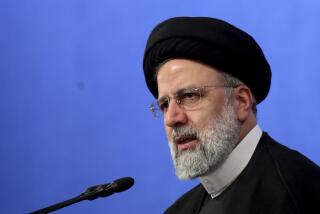Can Iran deliver on promises to ramp up oil production?

An Iranian oil worker rides a bicycle at a refinery south of Tehran in December 2014.
The prospect of Iranian crude oil returning to global markets that are already oversupplied has piled additional pressure on prices that recently fell below $30 a barrel.
The International Energy Agency, a leading industry watchdog, is forecasting that supply could exceed demand by 1.5 million barrels per day in the first half of the year.
“Unless something changes, the oil market could drown in oversupply,” it warned in a recent report.
See more of our top stories on Facebook >>
Adding to the glut would not seem to be in the interests of a country that is counting on oil profits to help revive an economy crippled by Western sanctions. But Iranian officials say they are less worried about low prices than about reclaiming the market share lost to Saudi Arabia, Russia and other big oil producers.
Iranian crude exports stand at about 1.1 million barrels per day, about half their pre-sanctions level. With the lifting of restrictions aimed at curbing Iran’s nuclear activities on Jan. 16, the government is vowing to increase output by 500,000 barrels a day within weeks and to add another 500,000 barrels before the year is out.
“It’s our right to return to the level of production we historically had,” Iran’s oil minister, Bijan Zangeneh, told reporters in November.
But can the country ramp up production that quickly? Many experts are skeptical.
The U.S. government’s Energy Information Administration is forecasting that Iran will add about 300,000 additional barrels of crude in 2016 and another 500,000 more in 2017.
Some analysts ascribe Iran’s more ambitious targets to political posturing. The country is trying to reassert authority in the Organization of the Petroleum Exporting Countries after losing ground to its chief regional rival, Saudi Arabia. The government also needs to reassure its population that the highly anticipated economic dividends of a landmark nuclear deal are on the way.
No one doubts the potential in Iran. Once the second-largest producer in OPEC, the Islamic Republic sits atop the world’s second largest gas reserves and the fourth-biggest petroleum reserves.
Iran was producing an average of 3.7 million barrels of crude a day in 2011, before the start of U.S. and European Union sanctions that limited the country’s ability to export oil and prevented it from importing the latest Western technology and equipment.
Although industry analysts believe it should be possible to bring back some of that production relatively quickly, more investment will be needed to achieve the kind of levels promised by the government, they say.
“We’re talking about opening oil fields, freshening up infrastructure, putting new capacity in place, new technology in fields,” said Julius Walker, a senior energy consultant for JBC Energy, a Vienna-based research firm. “All of this is a question of time and not something that can happen in the very short term.”
Iran’s Oil Ministry has said it hopes to attract $100 billion in foreign investment to modernize the energy sector. That could prove challenging, according to some analysts.
“Do people have confidence to put their money to work in Iran? There isn’t much of a favorable record so far for foreign investors,” said Sadad Ibrahim al-Husseini, a former executive with Saudi Arabia’s state oil company Aramco. “What I’ve heard from oil people in general is that the terms [Iran is offering] are not sufficiently attractive.”
Iranian analysts dispute that. Reza Zandi, an energy columnist for a reformist Iranian newspaper, said the enthusiasm among investors is evident from the list of visitors received at the Oil Ministry, including high-level delegations from Britain, Germany, Denmark, Austria, Italy, Russia and China. Even before the nuclear deal was signed in July, non-American oil majors like Anglo-Dutch Shell and Italy’s ENI were courting Iranian partners.
Iranian President Hassan Rouhani has been using a trip to Europe this week to try to woo back old customers and drum up new business. A number of deals have been inked in recent days, including with Greece’s biggest oil refiner, Hellenic Petroleum, the Italian oil-field services company Saipem SpA and Italian energy group Ansaldo Energia.
But Iran faces competition from Saudi Arabia, Russia and Iraq, which have poured oil into Europe, as well as Asia, where Tehran is hoping to sell additional barrels to customers it was able to retain despite the sanctions.
“The key to understanding whether or not Iran will be able to market a lot of this crude is to what extent they are going to be willing to discount their crude very aggressively in order to be able to undercut other producers,” Walker said.
Saeed Laylaz, a pro-government economist in Iran, said the country’s production costs are low, about $7 per barrel for crude. “So even if the price falls to $15 per barrel, Iran can afford to export it,” he said.
There are also other inducements that Tehran could offer, including deferred payments or investments in the foreign refineries that will use its crude.
But many foreign oil and services companies are holding back until some of the ambiguity about doing business with Iran is resolved.
Although the United States has lifted the sanctions it imposed on the Islamic Republic’s nuclear program, companies are wary of running afoul of other restrictions that remain in effect. There is also concern that some sanctions could snap back if Iran doesn’t fulfill its commitments under last year’s deal, or if a Republican president moves into the White House.
With prices so low, there is no reason to rush in. Last week, the price for a barrel of crude plunged below $27 for the first time in 12 years. It was trading at just over $32 Wednesday.
“To be very blunt, it would have been a lot easier to invite investors if there was a big shortfall of supply in the market, if oil prices were pushing $100-plus dollars, and oil companies were anxious to get their hands on reserves, but this is not the case,” al-Husseini said. “It’s probably the worst time possible for Iran to be trying to invite investors.”
Staff writer Alexandra Zavis reported from Los Angeles and special correspondent Ramin Mostaghim from Tehran.
For more international news, follow @alexzavis on Twitter
ALSO
Iranian leader, saying nation ‘stable and safe,’ meets pope
Stocks claw higher after an early drop, helped by oil prices
More to Read
Start your day right
Sign up for Essential California for news, features and recommendations from the L.A. Times and beyond in your inbox six days a week.
You may occasionally receive promotional content from the Los Angeles Times.







